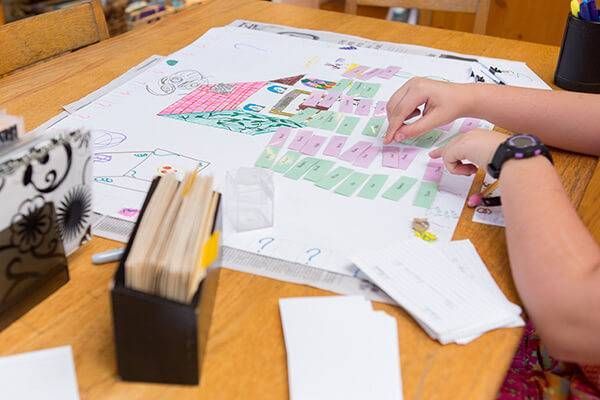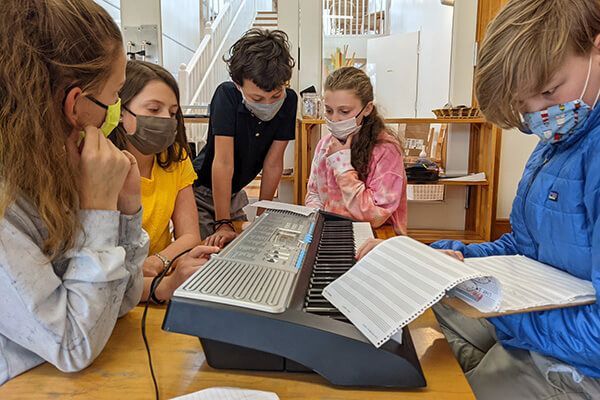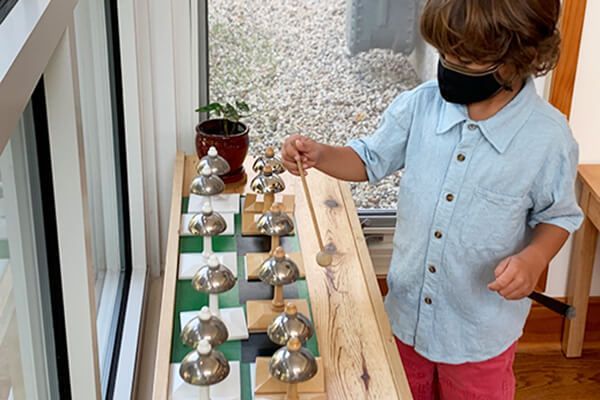The Arts

Submitted by Laura Earls, with edits and contributions by Margaret Kelley In a Montessori classroom, experiences with art, culture, and nature are embedded in the curriculum. Instead of viewing these parts of life solely as separate categories for study, Dr. Montessori believed that they were also inherently intertwined with the children’s daily lessons and work. So much of a human being’s relationship to art, culture, and nature is simply a relationship to beauty. Children who learn in a Montessori environment come to see beauty everywhere—both as something to create, as well as something to appreciate. This ability serves them throughout life, deepening their relationship with art, culture, and the natural world. As teachers, we make sure to celebrate true beauty—encouraging it and elevating it in all aspects of the classroom. By showing the children how to create it through their work, how to appreciate it in the world around them, and how to engage with it in nature and culture, we give them a map for incorporating it into their lives as they venture outside of the classroom. These lessons provide children with a foundation for always appreciating the beauty they find around them, both manmade and natural—giving their lives meaning, and making the world a precious and cherished place to live. Art Making Work Beautiful A Montessori teacher helps their students to strive for beauty in their work. There are distinct art lessons, but there is also the practice of making academic projects beautiful. When children bring their work home, parents may notice that no single sheet of paper is left plain! Once a child completes a piece of paper in any subject, they may decorate their work. Ornamentation on their finished reports is a lovely way for them to feel that their work is special and very much their own.

“They had no idea how much their lives would change.” This thought has been uttered thousands of times in the last year—maybe millions. It describes how we all have felt at some point—at many points—since the Covid-19 pandemic started. But we are not unique in human history. Entire populations of countries have been affected by hardships throughout time—by war, by drought, and, yes, also by pandemics. While we have not lived through a pandemic of this magnitude in our own lifetimes, this is not a novel event in history. And as real as the tragedy and trauma of the past year have been, there is some comfort in knowing that humanity has survived events like this before. This particular sentence—“They had no idea how much their lives would change”—is so exquisite because it is a line in a musical written by 11- and 12-year-olds. When their lives changed in 2020 in extraordinary ways, these Montessori children had hearts and imaginations large enough to recognize that their experiences, however challenging, were not unique to themselves or to this moment in history. When these elementary children were given the opportunity to write the musical for a school-wide performance for Forest Bluff School, they, of their own accord, chose to write it about pandemics throughout history: the Bubonic Plague, Yellow Fever, and the Flu of 1918. Our Head of School Paula Preschlack observed, “They used stories from the past to normalize what is happening to us now.” With a Montessori perspective, these students reminded themselves and each other that people have lived through similar circumstances before. And they found that, each time, people survived with kindness, courage, and new scientific discoveries. They saw that people did the best they could with what they had. They also recognized the importance of all the discoveries humans have made before our time. As one of the characters in the script observes, “Thank goodness for all the hard working humans of the past. Without their toil and thankless effort, none of the tools we rely on today would be possible.” Re-envisioning the Drama Workshop In 2020, our school was unable to hold the annual Drama Workshop. Normally at this event, Drama Director Phyllis Mount, her son Max Mount, and her grandchildren wrote scripts, songs, music, and dances for our 60 elementary students (ages 6-12). Each year, the drama directors read the scripts with the students, assign parts, assist in practice and music, and then complete the program with a week at Gorton Community Center where the children work intensively for five days and finish with a performance in the evening in front of friends and family. This year, Forest Bluff School had the great fortune of being open and in-person for this entire school year, besides a few isolated class closings. While much of the learning has been the same for children, there are still differences due to Covid protocols: mask wearing, social distancing, assigned seating, and daily health checks, to name just a few. By January of 2021, it became clear that even with the success our school has had in staying open in a safe and healthy way, the traditional Drama Workshop would be impossible. Additionally, we received the news that the member of the Mount family who was planning to be our drama director this year had to recover from an illness, making it impossible for him to come to our school to lead the children. Our teachers and Head of School wanted desperately to give the students a chance at their Drama Workshop, especially in a year when so much has been taken away by the circumstances of the pandemic. They took the time to reimagine the possibilities and came up with a plan that was bold, exciting, and, ultimately, more “Montessori” than ever. They considered the fall, when the oldest Upper Elementary children wanted to create a play together. Their teacher recognized their strong urge to work together collaboratively, and encouraged them with this big project. After more than a month of hard work, rehearsals at school, original costumes, and extra meetings outside of school, the children presented their original rendition of “When Pigs Fly” to the whole school outside. It was polished and entertaining, and they produced the entire endeavor with minimal adult assistance.

Music Lifts Us Up! Those of us working in Forest Bluff’s office often feel separated from the life of the classrooms during this time of COVID restrictions because we cannot open the doors to see the children working. But one thing has warmed our hearts every single day: the sound of music coming from everywhere. Children are always singing or playing the bells or the tone bars, every day. In this way, original musical expression is the backdrop to the Montessori classrooms. Our children experiment with melodies as a way to learn about humanity and articulate their understanding of the environment. Music is fun, but it is also a launching point to explore physics, history, language, geography, and arithmetic. Music also involves group coordination, executive functioning, and compromise; this is required to organize a performance, which some of our brave upper elementary children decided to tackle, earlier this year. Music is an important and vital part of our lives. However, it’s easy to overlook its value in children's education. We admit that even in a Montessori school that follows an education designed to integrate all aspects of life, we often have much more left to teach in the extensive Montessori music curriculum. In a society that prizes educational topics such as mathematics, language, and science, music can be thought of as an extra, less necessary, part of schooling. But because all subjects are interdependent, both in life and in the Montessori approach, we spend time exploring the significantly worthwhile language of music: its mechanics and its context. Every aspect of musical study has many links to other topics. Making these connections enriches the lives of the children, their outlook on human history, and their understanding of sound and music physically, intellectually, and spiritually. Music is good for our souls. It helps us work through emotions, lifts our moods, and gives us a sense of close connection to our fellow human beings! Music in the Classroom: Silence, Movement, and Imagination Dr. Montessori took the time to point out the value of music in all aspects of our lives. One of the most important elements of her approach is the emphasis on silence and its important role. Young children develop an awareness of the role silence plays in their teachers' instructive presentations, where their expressions and movements are highlighted by the absence of talking. Being silent also requires each child to exercise self-control. Montessori’s “Silence Game,” which is a simple meditation in silence, points to the relationship of silence to the sounds we make when we move our bodies. Children develop intense concentration when working with and creating music, because controlling their movements is challenging for them. The bells and the tone bars are music materials that elicit hours of focus and flow state concentration. When children have the opportunity to work in a state of flow, the mental faculties associated with concentration are strengthened. Concentrating on music is practice that makes it easier for children to concentrate on other important developmental tasks through their education and life experiences.
